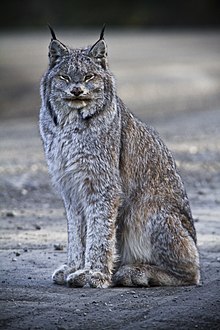Post by dinosauria101 on Aug 28, 2019 9:27:54 GMT 5
Canadian Lynx - Lynx canadensis
The Canadian lynx ranges in Alaska, Canada, and the states of Montana, Idaho, Washington, and possibly some New England states such as New York and Maine in the United States. Canadian lynxes can easily be distinguished from bobcats by their tails: lynxes tails are tipped in black all around the tail whereas bobcat's tails are solid black on the top and white underneath. Lynxes also have larger feet, a more prominent facial ruff, longer legs, soles covered in hair, and the ear tufts are longer. This lynx's diet consists exclusively of the snowshoe hare. Their population is closely linked to this hare, so when the population of the snowshoe hare drops, so does that of the lynx. The drop is noticed in the number of cubs born and the infant mortality rate. They may feed on small rodents, ptarmigan, and red deer, but they refuse to switch to anything other than snowshoe hare as their main prey when the population drops. The Canada lynx is a medium-sized cat, similar in many ways to the bobcat. This lynx is between 80 and 100 centimetres (31 and 39 in) in head-and-body length, stands 48–56 centimetres (19–22 in) tall at the shoulder and weighs 5–18 kilograms (11–40 lb). It is smaller than its Eurasian cousin, at an average weight of 8 to 11 kg (18 to 24 lb). Males are larger than females. Although the species is larger on average than the bobcat, it is less variable in size and the largest bobcat outsize the lynx.

American Badger - Taxidea taxus
The American badger (Taxidea taxus) is a North American badger, somewhat similar in appearance to the European badger. It is found in the western and central United States, northern Mexico and central Canada, as well as in certain areas of southwestern British Columbia. Their habitat is typified by open grasslands with available prey (such as mice, squirrels, and groundhogs). They prefer areas with sandy loam soils where they can dig more easily for their prey, such as prairie regions. The American badger has most of the general characteristics common to badgers; stocky and low-slung with short, powerful legs, they are identifiable by their huge foreclaws (measuring up to 5 cm in length) and distinctive head markings. Measuring generally between 60 to 75 cm (23.6 to 29.5 inches) in length, males of the species are a little bit larger than females (with an average weight of roughly 7 kg (15.5 pounds) for females and up to almost 9 kg (19.8 pounds) for males). Northern subspecies such as T. t. jeffersonii are heavier than the southern subspecies. In the fall, when food is plentiful, adult male badgers can exceed 11.5 kg (25.3 pounds).

Credit to Wikipedia
The Canadian lynx ranges in Alaska, Canada, and the states of Montana, Idaho, Washington, and possibly some New England states such as New York and Maine in the United States. Canadian lynxes can easily be distinguished from bobcats by their tails: lynxes tails are tipped in black all around the tail whereas bobcat's tails are solid black on the top and white underneath. Lynxes also have larger feet, a more prominent facial ruff, longer legs, soles covered in hair, and the ear tufts are longer. This lynx's diet consists exclusively of the snowshoe hare. Their population is closely linked to this hare, so when the population of the snowshoe hare drops, so does that of the lynx. The drop is noticed in the number of cubs born and the infant mortality rate. They may feed on small rodents, ptarmigan, and red deer, but they refuse to switch to anything other than snowshoe hare as their main prey when the population drops. The Canada lynx is a medium-sized cat, similar in many ways to the bobcat. This lynx is between 80 and 100 centimetres (31 and 39 in) in head-and-body length, stands 48–56 centimetres (19–22 in) tall at the shoulder and weighs 5–18 kilograms (11–40 lb). It is smaller than its Eurasian cousin, at an average weight of 8 to 11 kg (18 to 24 lb). Males are larger than females. Although the species is larger on average than the bobcat, it is less variable in size and the largest bobcat outsize the lynx.

American Badger - Taxidea taxus
The American badger (Taxidea taxus) is a North American badger, somewhat similar in appearance to the European badger. It is found in the western and central United States, northern Mexico and central Canada, as well as in certain areas of southwestern British Columbia. Their habitat is typified by open grasslands with available prey (such as mice, squirrels, and groundhogs). They prefer areas with sandy loam soils where they can dig more easily for their prey, such as prairie regions. The American badger has most of the general characteristics common to badgers; stocky and low-slung with short, powerful legs, they are identifiable by their huge foreclaws (measuring up to 5 cm in length) and distinctive head markings. Measuring generally between 60 to 75 cm (23.6 to 29.5 inches) in length, males of the species are a little bit larger than females (with an average weight of roughly 7 kg (15.5 pounds) for females and up to almost 9 kg (19.8 pounds) for males). Northern subspecies such as T. t. jeffersonii are heavier than the southern subspecies. In the fall, when food is plentiful, adult male badgers can exceed 11.5 kg (25.3 pounds).

Credit to Wikipedia



